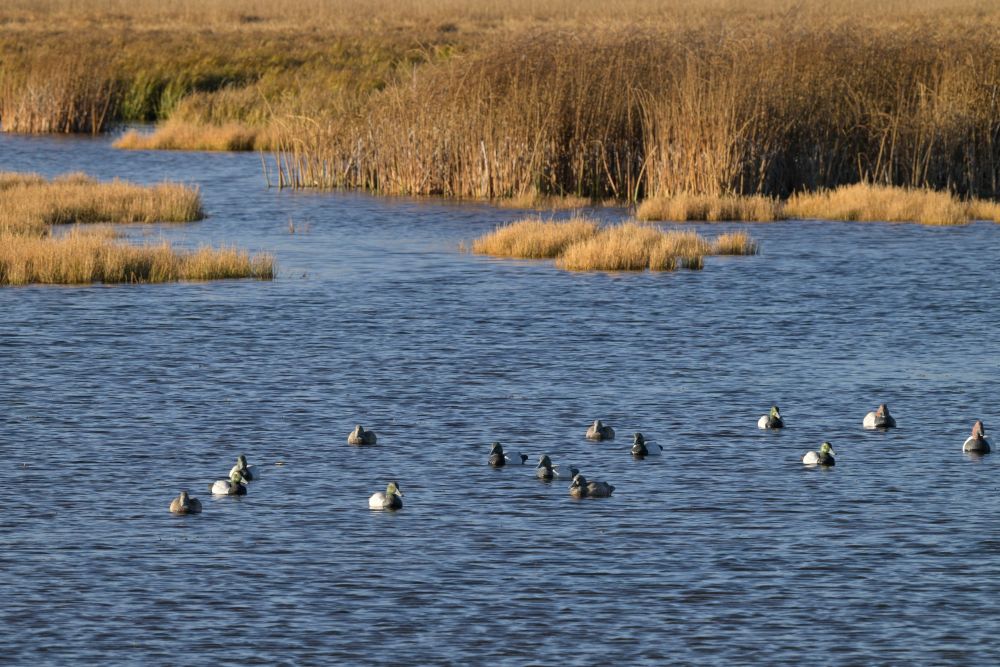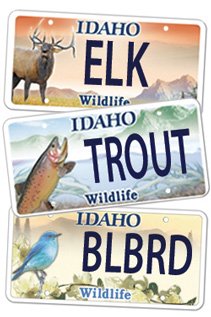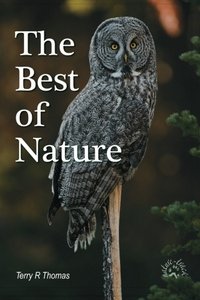Decoys

A flotilla of decoys looked real enough to fool me.
On a quick trip to Red Rock Lakes several weeks ago, we hurried to the west end where we usually have the best birding. As we pulled up to the small low-head dam, we quickly noted a flock of about 20 ducks near the dam. There were also three other vehicles there, although no people were in sight.
We and took a look at the birds with our binoculars. I immediately recognized the sloping bill and forehead of the Canvasback, one of the most popular ducks for duck hunters. There was something wrong with the colors though and I assumed that the birds were just in transition between eclipse and breeding plumage. I mentioned as much to my wife and half-jokingly she said, “maybe they are decoys.” Shocked at the thought that a duck hunter might have his spread so close to the parking area, I just guffawed—while taking a closer look. Sure enough, the ducks were rocking a bit in the breeze, but otherwise weren’t moving and close examination with the spotting scope revealed their plastic origins. We had a good laugh, remembering when Cathy got all excited about a great-horned owl decoy and she felt vindicated by my humiliation.
What are decoys? Decoys are reproductions of birds and animals placed with the intent of attracting those birds or animals close enough to capture or harvest. The known use of decoys dates back to 2500 BC when ancient Egyptians used waterfowl decoys made of clay in the Nile River to capture ducks and geese. Native Americans have been using waterfowl decoys made from reeds for at least 2000 years.
However, Native Americans took decoys well beyond the waterfowl stage. Before the introduction of the horse, they would dress a fast runner in a bison calf skin, essentially a living decoy. This runner would then approach the herd, and using distress calls, would lead them toward a cliff, called a buffalo jump, or a corral. At the same time, other Native Americans draped in wolf pelts would converge on the sides to add predation risk. At the final moments, additional members of the tribe would approach, waving blankets to get the bison to commit to a run off the cliff (or into the corral).
This technique of dressing in an animal skin also allowed Native Americans to slowly sneak up on prey or attract animals such as deer or elk into closer range.
Waterfowl decoys really came into their own in the 1800’s as market hunting, professional hunters supplying the meat markets and restaurants with waterfowl, took hold. At one time, waterfowl was considered a delicacy and a hunter could sell birds for one to two dollars each, sometimes earning $100 a day in an era where a dollar a day was considered a decent wage. Spreads of two to three hundred decoys were needed to attract the huge flocks of the day and an industry of decoy carvers was born.
Today, most decoys used by waterfowl hunters are made commercially from plastics. They are lighter, far less expensive and often stack together. Decoy carving has remained an art form though and many carvers demand top dollar for their creations.
Besides decoys that imitate the intended target species, there are other decoys often called confidence decoys. Wild animals and birds pay attention to other species. It seems that the more diverse the species, the safer the area. Wildfowl hunters will use a wide variety of other birds such as great blue herons, egrets, American coots, Canada geese, and even swans to convince ducks it is a safe haven.
Decoys for wildfowl are just part of the decoy world. Elk hunters, turkey hunters, and pronghorn hunters also use full-sized decoys, albeit 2-D rather than 3-D for the larger ones.
Decoys are still in use because they are one of the most effective hunting tools. It stands to reason then, that humans can be just as susceptible to decoys that can lead us into some of the traps or off some cliffs in this world. Watch out for things that seem to be too good to be true, because as the saying goes, they usually are.
Help Idaho Wildlife
When we traveled across the state in October 2017, we visited most of the Idaho Department of Fish and Game wildlife management areas. Most of the vehicles we saw using the wildlife management areas did not have wildlife plates. Buying wildlife plates is a great way for non-hunters and hunters alike to support wildlife-based recreation like birding.
C'mon folks, let's help Idaho's wildlife by proudly buying and displaying a wildlife license plate on each of our vehicles!
See below for information on Idaho plates. Most states have wildlife plates so if you live outside Idaho, check with your state's wildlife department or vehicle licensing division for availability of state wildlife plates where you live.
And tell them that you heard about it from Nature-track.com!

Wildlife License Plates
Great news! as of 2024, there are three NEW designs for license plates. They still are bluebird, cutthroat trout and elk, but they are beautiful.
Idaho Wildlife license plates provide essential funding that benefits the great diversity of native plants and wildlife that are not hunted, fished or trapped—over 10,000 species or 98% of Idaho’s species diversity. Game species that share the same habitats (such as elk, deer, antelope, sage-grouse, salmon, trout) also benefit from these specialty plates.
No state tax dollars are provided for wildlife diversity, conservation education and recreation programs. Neither are any revenues from the sale of hunting or fishing licenses spent on nongame species. Instead, these species depend on direct donations, federal grants, fundraising initiatives—and the Idaho Wildlife license plates.
Both my vehicles have Bluebird Plates. I prefer the bluebird because the nongame program gets 70 percent of the money from bluebird plates, but only 60 percent of the money from elk and trout plates - 10 percent of the money from elk plates supports wildlife disease monitoring and testing programs (to benefit the livestock industry) and 10 percent from cutthroat plates supports non-motorized boat access.
Incidentally, in 2014, the Idaho Legislature denied the Department of Fish and Game the ability to add new plates or even to change the name of the elk and cutthroat plates (very specific) to wildlife and fish plates, a move that would have allowed for changing images occasionally and generating more revenue. It would seem that they believe that we Idahoans don't want a well funded wildlife program.
I think it is time we let the Legislature know that Idahoan support wildlife funding and that we would like to see these generic plates come to fruition.

"WOW. What a phenomenal piece you wrote. You are amazing." Jennifer Jackson
That is embarrassing, but actually a fairly typical response to my nature essays. Since The Best of Nature is created from the very best of 16 years of these nature essays published weekly in the Idaho Falls Post Register (online readership 70,000), it is a fine read. It covers a wide variety of topics including humorous glimpses of nature, philosophy, natural history, and conservation. Readers praise the style, breadth of subject matter and my ability to communicate complex and emotional topics in a relaxed and understandable manner.
Everyone can find something to love in this book. From teenagers to octogenarians, from the coffee shop to the school room, these nature essays are widely read and enjoyed.
Some of the essays here are my personal favorites, others seemed to strike a chord with readers. Most have an important message or lesson that will resonate with you. They are written with a goal to simultaneously entertain and educate about the wonderful workings of nature. Some will make you laugh out loud and others will bring a tear to the eye and warm your heart.
Readers Write:
"You hit a home run with your article on, Big Questions in Nature. It should be required reading for everyone who has lost touch with nature...great job!" Joe Chapman
"We enjoyed your column, Bloom Where Planted. Some of the best writing yet. The Post Register is fortunate to have your weekly columns." Lou Griffin.
To read more and to order a copy, click here or get the Kindle version
Copies are also available at:
Post Register
Island Park Builders Supply (upstairs)
Barnes and Noble in Idaho Falls
Harriman State Park, Island Park
Museum of Idaho
Valley Books, Jackson Wyoming
Avocet Corner Bookstore, Bear River National Wildlife Refuge, Brigham City, Utah
Craters of the Moon National Monument Bookstore, Arco, Idaho